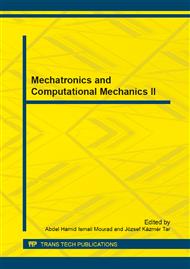[1]
T.J. Kim, D.Y. Yang, Improvement of formability for the incremental sheet metal forming process, Int. J. Mech. Sci. 42 (2000) 1271.
Google Scholar
[2]
M.S. Shim, J.J. Park, Deformation characteristics in sheet metal forming with small ball, Trans. Mater. Process. J. JSTP 113 (2001)654.
Google Scholar
[3]
H. Iseki, An approximate deformation analysis and FEM analysis for the incremental bulging of sheet metal using a spherical roller, J. Mater. Process. Technol. 111 (2001) 150.
DOI: 10.1016/s0924-0136(01)00500-3
Google Scholar
[4]
M.S. Shim, J. -J. Park, The formability of aluminum sheet in incremental forming, J. Mater. Process. Technol. 113 (2001) 654.
Google Scholar
[5]
Y. -H. Kim, J. -J. Park, Effect of parameters on formability in incremental forming of sheet metal, J. Mater. Process. Technol. 130 (2002) 42.
Google Scholar
[6]
Kitazawa, K., Hayashi, S., Yamazaki, S. Hemispherical stretch-expanding of aluminum sheet by computerized numerically controlled incremental forming process with two path method. Journal of Japan Japan Institute of Light Metals, vol. 46, 2001pp. 219-224.
DOI: 10.2464/jilm.46.219
Google Scholar
[7]
Powell N. and Andrew, C. Incremental forming of flanged sheet metal components without dedicated dies. IMECHE part B, J. of Engineering Manufacture, 1992, vol. 206, p.41 – 47.
DOI: 10.1243/pime_proc_1992_206_054_02
Google Scholar
[8]
Jeswiet, J., Hagan, E. Rapid Proto-typing of a Headlight with Sheet Metal, Proceedings of Shemet, April 2001, pp.165-170.
Google Scholar
[9]
Kim, T.J., Yang, D.Y. Improvement of formability for the incremental sheet metal forming process. International Journal of Mechanical Sciences, vol. 42, pp.1271-1286, (2001).
DOI: 10.1016/s0020-7403(99)00047-8
Google Scholar
[10]
Leach, D., Green, A. J., Bramley, A. N., A new incremental sheet forming process for small batch and prototype parts. 9th International Conference on Sheet Metal, Leuven, pp.211-218, (2001).
Google Scholar
[11]
Filice, L., Fantini, L., Micari, F. Analysis of Material Formability in Incremental Forming, Annals of the CIRP, vol. 51/1/2002: 199-202.
DOI: 10.1016/s0007-8506(07)61499-1
Google Scholar
[12]
Jadhav S., Goebel R., Homberg W., Kleiner M.: Process optimization and control for incremental sheet metal forming, Proceedings of the International Deep Drawing Research Group Conference, IDDRG, Pg. 165-171, Bled, Slovenia, May (2003).
Google Scholar
[13]
Micari, F. and Ambrogio, G. A Common shape for conducting Incremental Forming Tests. 1 Incremental Forming Workshop, University of Saarbrucken, 9 June 2004. On Cdrom.
Google Scholar
[14]
M. Joseph Davidsona, K. Balasubramanianb, G.R.N. Tagorea, Surface roughness prediction of flow-formed AA6061 alloy by design of experiments, journal of materials processing technology 202 (2008) 41–46.
DOI: 10.1016/j.jmatprotec.2007.08.065
Google Scholar
[15]
Choudhury, I.A., El-Baradie, M.A., 1997. Surface roughness prediction in the turning of high strength steel by factorial design of experiments. J. Mater. Process. Technol. 67, 55–61.
DOI: 10.1016/s0924-0136(96)02818-x
Google Scholar
[16]
Joseph Davidson, M., Balasubramanian, K., Tagore, G.R.N., 2008 Experimental investigation on flow-forming of AA6061 alloy—a Taguchi approach. J. Mater. Process. Technol. 200, 283–287.
DOI: 10.1016/j.jmatprotec.2007.09.026
Google Scholar


